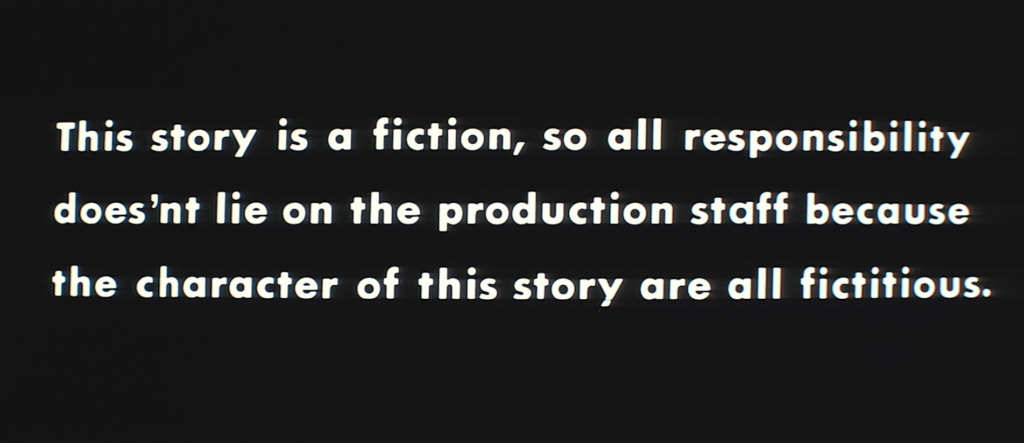Osamu Tezuka’s Sci-Fi Historical Epic Mash-Up is an Ambitious, Disjointed Disaster
DIRECTED BY: OSAMU TEZUKA AND EIICHI YAMAMOTO/1970
BLU-RAY STREET DATE: 10/27/2020
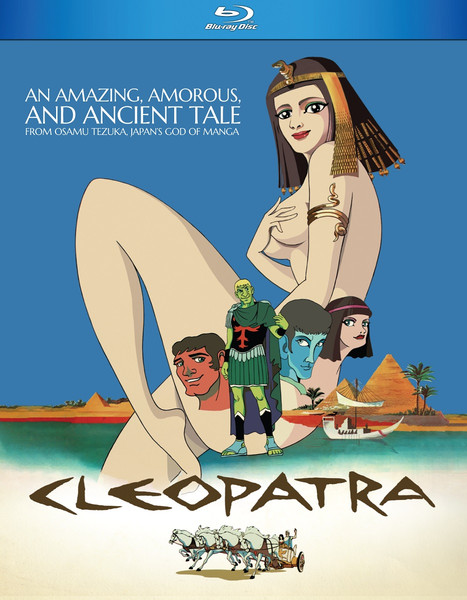
With 1969’s A Thousand & One Nights, Mushi Productions revolutionized animation by creating the first animated feature aimed at adults. In 1970 they would break further ground with Cleopatra, creating the first bad animated feature film aimed at adults.
Calling 1970’s Cleopatra bad is an understatement. Helmed by Eiichi Yamamoto and studio founder Osamu Tezuka, the 2nd entry in Mushi Pro’s Animerama series following A Thousand & One Nights, fumbles in every way its predecessor succeeds. Suffering from a convoluted, disjointed narrative that utterly fails to convey the gravity of a historical epic, considerable sexism and even homophobia, weak visual design rife with failed experiments, highly limited and less inventive animation, and stock score, Cleopatra is a fascinating train wreck of a film, its few positives eclipsed by list of cons longer than the Nile. Even Discotek Media’s typically high-quality presentation does little to salvage this baffling mess of a film.
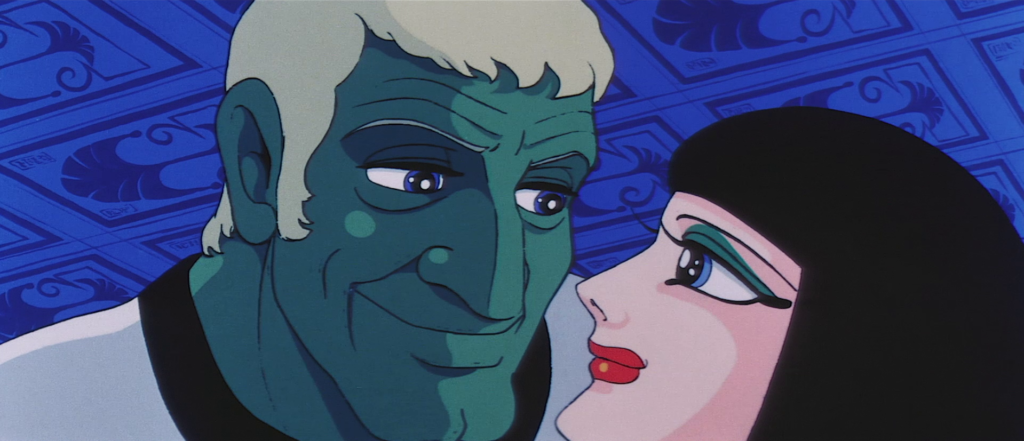
The story opens not in ancient Egypt, but in the distant future, as we are a shown a model spaceship, then zoom through a futuristic city in a POV shot of a hover car. Arriving at our destination, we are introduced to Maria Ferro, Jiro Tani, and Hal Witcher – presented as animated heads on live-action bodies – that are to have their minds transported back to ancient Egypt to determine the nature of the resistance force on the planet Pastorine’s “Cleopatra Plan”. Sent back into the minds of Egyptian city girl Libya, Roman slave Ionius, and Cleopatra’s pet leopard Lupa respectively, the trio arrive in the midst of Julius Caesar’s bloody conquests. Embroiled in the drama and political intrigue of the time, the three eventually all manage to become companions of Cleopatra in the hopes of determining just what the mysterious Cleopatra Plan is.
Cleopatra, initially presented as a homely virgin expelled from the palace by her brother, the Pharaoh, is made an agent of the Egyptian resistance. Taken to the temple at Thebes by her caretaker Apollodoria, she is transformed into a seductive beauty through magical means so she might get closer to Caesar and kill him. While this plan seems to work, Cleopatra finds herself falling for Caesar, bearing his child and following him to Rome. It is only when she is rebuffed that she finally aids in his assassination, before returning to Egypt and seducing the bumbling Marcus Antonius, setting the stage for his confrontation with Caesar’s nephew Octavian at the Battle of Actium, and the queen Cleopatra’s ultimate fate.
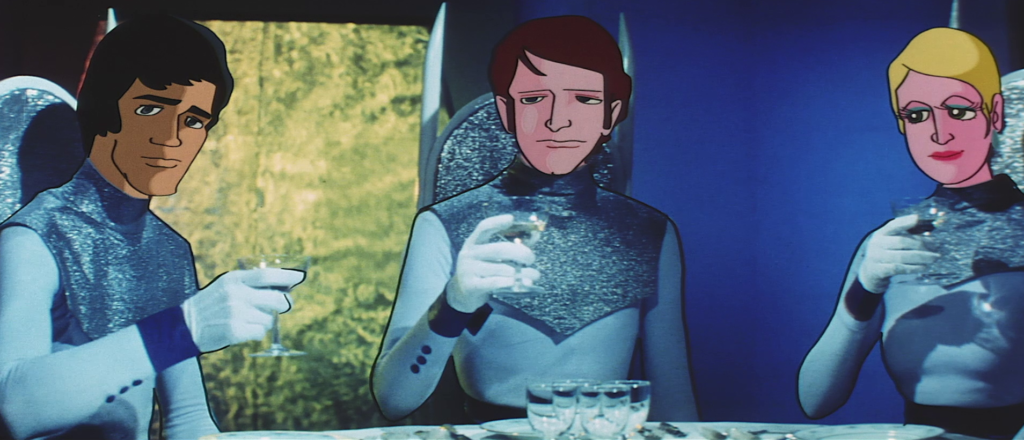
The narrative is a mess of half coherent vignettes. The framing device of the future segments does very little to actually influence the plot, only confusing things and resulting in a potentially interesting ending wasted in the service of a paragraph of hokey text explaining the Cleopatra Plan. Characterization fluctuates wildly, and the narrative plods along without much explanation for why one scene leads to another, visual gags standing in stark contrast to explicit violence. The willingness of the film to engage in more erotic – “openly sexual” might be more apt, considering the film’s complete failure at eroticism – is also more of a detriment than a boon, as it actively harms the depiction of its titles character, and opens the door for some rather unfortunate depictions of LGBTQ+ characters.
Cleopatra herself is depicted as a waif. Unable to ever really commit to enacting violence herself, she is presented as hopeless obsessed with all the men who enter her life. Any attempts at assassination are thwarted or conflated with her sexuality; even when she sneaks into Caesar’s room to kill him her black cloak is designed so the viewer can ogle her bare chest. Her abilities of seduction are initially presented as a weapon to be used against others, but even this modest advantage is curtailed when she falls in love with almost all those she uses it against, save for Octavian, who instead breaks his cool, composed attitude to gush about how he has fallen in love with Ionius. While the effete presentation of Octavian is wince-inducing, it’s nowhere near so troubling as the depiction of Apollodoria. She is the one who recruits Cleopatra into the military, bloodthirsty and conniving she is presented as physically unattractive, sexually predatory lesbian groomer. Frequently touching Cleopatra in ways she is uncomfortable with, Apollodoria is a deeply troubling depiction of a lesbian character, and her presence undercuts much of the enjoyably bad and outlandishly silly elements of the film.
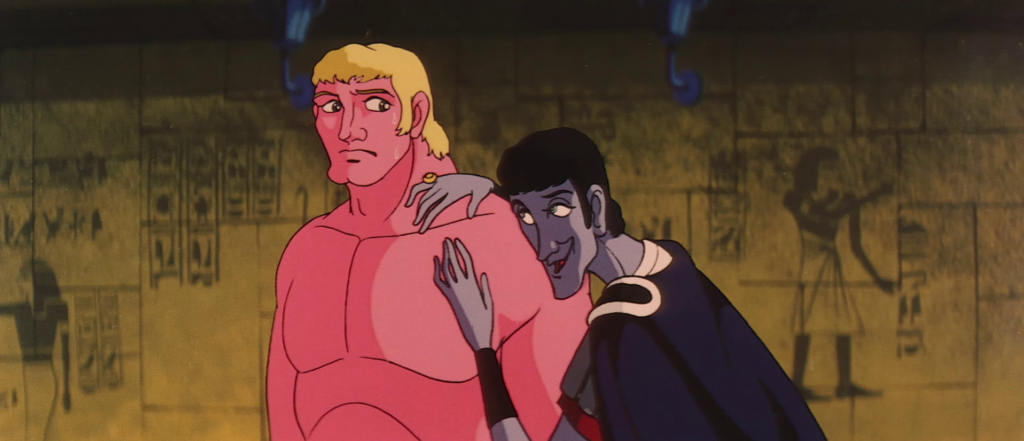
Admittedly, it is difficult to discern just how unattractive Apollodoria is within the context of the film, considering how unappealing nearly every character looks. Designed by Kou Kojima, author of the manga Sennin Buraku, the characters in Cleopatra seem to be a marriage of the worst qualities of his own art style with those of A Thousand & One Nights. Cleopatra once against suffers the most, her oddly proportioned face and lips giving a perpetual dead-eyed look as she is unable to be expressively animated so as to preserve her “beauty”. Her design is likely an attempt to convey a style reminiscent of hieroglyphics, a style which falls apart when viewed outside of the limited perspective of a side profile. To try and accommodate this, much of the film’s composition is far more limited than in A Thousand & One Nights, offering much less dynamic photography and losing those gorgeous, expressive close-ups.
The experimentation in stylistic presentation is an erratic, thoroughly uneven affair. The model sets in the opening look quite nice, but the animation of the future characters is bafflingly bad. Akin to such experiments as synchro-vox in Clutch Cargo, the future characters are portrayed by live-action actors with thickly drawn around their bodies and animated, stylized heads. Rather than conventional rotoscoping, what is presented here is a sloppy, incredibly distracting effect with some of the worst animation in the feature, an effect only compounded by the typically unappealing design work for the stylized heads. Other elements of stylization, like the colorful expressive palettes used in the opening, the various painters’ styles employed in the parade celebrating Caesar’s return to Rome, Kabuki depiction of Caesar’s murder, and the stylized love scenes are compelling on their own, but clash with the more mundane visual style of the rest of the film. The various cameos by characters from the likes of GeGeGe no Kitaro, Osomatsu-kun, Kamui Den, and even Tezuka’s own Astro Boy are charming, but similarly do little to mitigate the film’s larger issues.
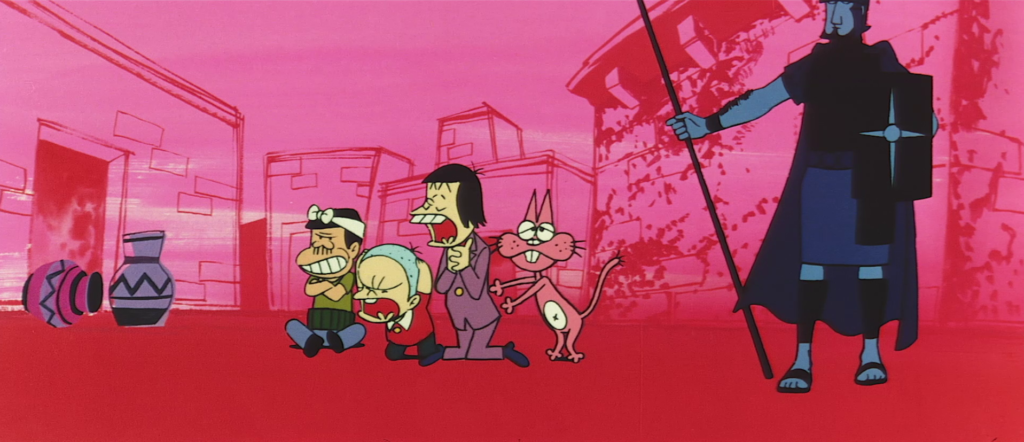
Animation is rough, but largely lacks the stylistic decision that helped to mitigate issues in A Thousand & One Nights. There are some enjoyable cuts, with the late Kazuko Nakamura handling Cleopatra’s animation with her typical skill, providing her movements a grace and subtlety that despite the fundamental issues with the character’s design. Despite this, much of the film is choppily animated, and barely above the standards of Mushi’s television out. Even notable highlights like Ionius’s fist fight with an Egyptian warrior are rather unimpressive compared to what director Osamu Dezaki was doing for Mushi Pro’s 1970 television adaptation of Ashita no Joe. Similarly, Gisaburo Sugii’s contributions to the love scenes, previously abstract and hypnotic in A Thousand & One Nights are here a much less interesting and more simplistically presented dance of only a few lines in gold and mirrored still paintings.
Cleopatra’s score is also far less interesting than either of the other Animerama entries, despite not being outright bad. Isao Tomita provides the lion’s share of music, and it’s more reminiscent of his work for television, never achieving the grand highs of his orchestral tracks in A Thousand & One Nights or anything so memorable as the funk and prog-rock inspired scores in the trilogy’s other entries. A pair of vocal tracks are also included, Guerilla no Uta by Rokumonsen and Cleopatra no Namida by Yuki Saori. Guerilla no Uta is enjoyably silly, but much like the rest of the score doesn’t really stick with the viewer, while Cleopatra no Namida is an enjoyable, melancholic piece that really deserved to be in a better movie.
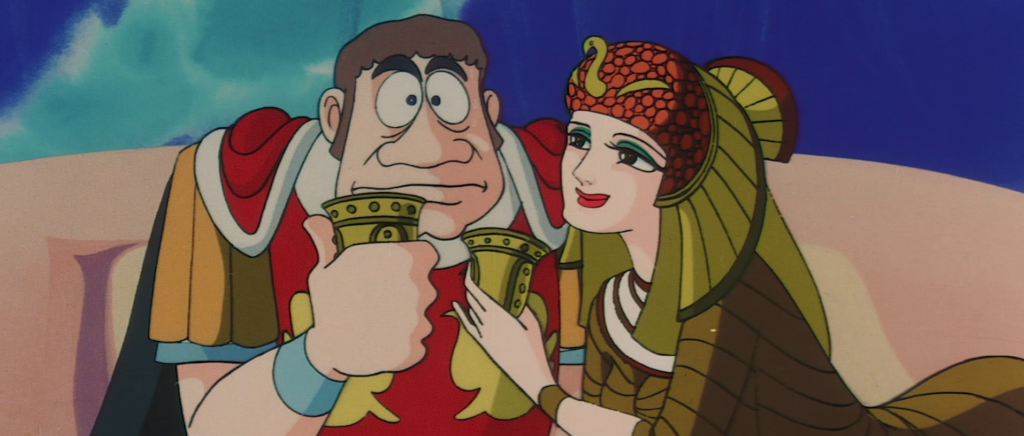
Discotek Media’s release of Cleopatra is the best thing about it. Relatively sparse compared to their release of A Thousand & One Nights, the film itself is presented with a high quality restoration typical of Discotek’s releases. The highlight of the extra features is a commentary by Helen McCarthy, which is highly informative and well-presented, possibly even more engaging than her commentary for A Thousand & One Nights. Lastly is the trailer, which is of a bit more interest due to it including a scene cut from the complete film, for those of you who couldn’t get enough Cleopatra.
As a whole Cleopatra is a jumbled, plodding, at times even offensive mess of a film. Its attempts at experimentation constantly go awry, those that do succeed integrate poorly into the rest of the film, its characters are entirely some combination of flat and inconsistent, and the visual style is massively unappealing, with animation that falls flat even compared to their television output. I do certainly admire some sequences, and Discotek’s high quality presentation at least benefits those few moments quite a bit. And like most train wrecks it is difficult to look away, the mess can be enjoyable if only for trying to divine what the creators were trying to do. But outside of those with an interest in the history of the medium and those looking for a subject for a bad movie night, I can’t recommend Cleopatra.
